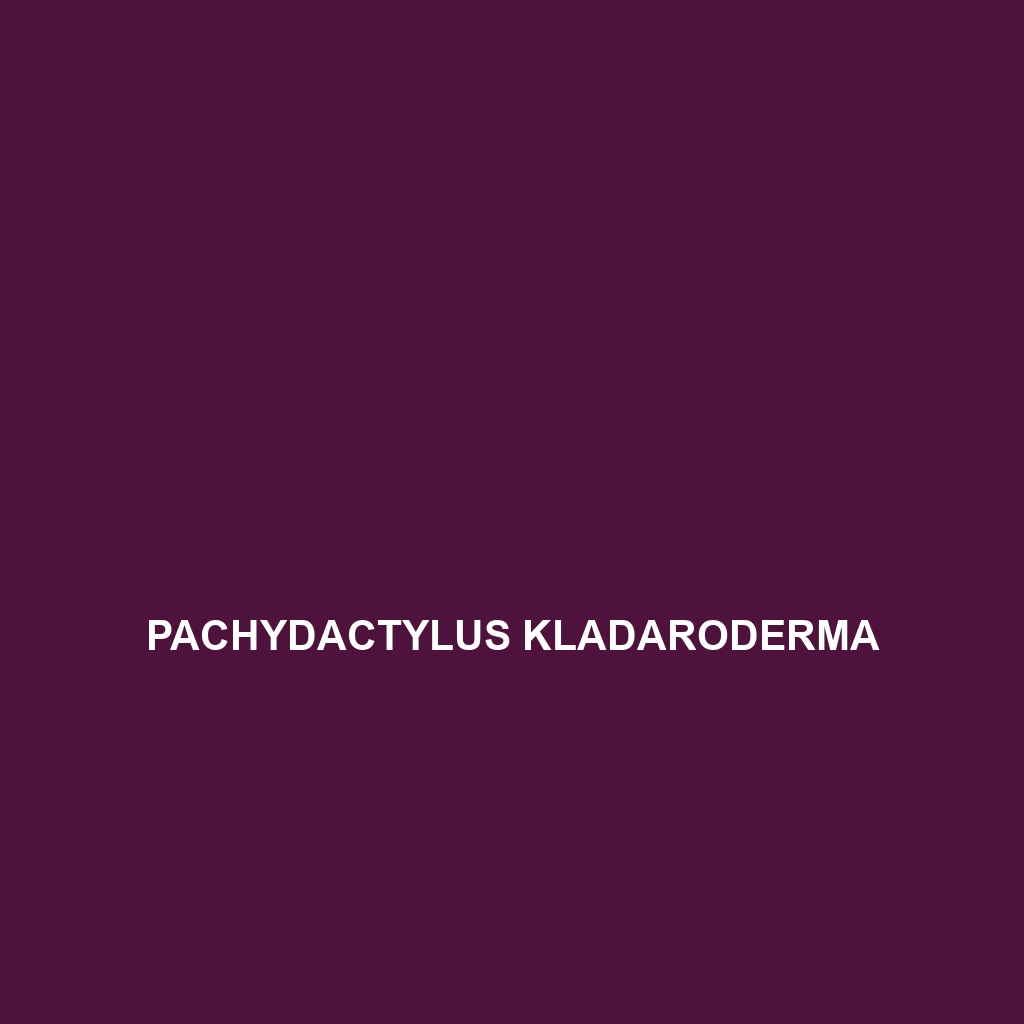Common Name
Pachydactylus kladaroderma
Scientific Name
Pachydactylus kladaroderma
Habitat
Pachydactylus kladaroderma, commonly known as the Central African thick-toed gecko, primarily inhabits the dry, rocky terrains of southern Africa, particularly in regions with arid climates. This species is predominantly found in the Namibia and South Africa area, thriving in semi-desert environments which often feature scattered shrubs and sparse vegetation. The ideal habitat includes rocky outcrops and places where they can easily hide from predators, such as under stones or in crevices. Due to its specialized requirements, Pachydactylus kladaroderma is not typically found in more humid climates like rainforests or temperate forests, but rather in locations that experience significant temperature variations between day and night.
Physical Characteristics
Pachydactylus kladaroderma displays a distinctive morphology characterized by its robust body and the thickened toe pads that facilitate climbing on rocky surfaces. Adult individuals typically measure between 12 to 15 centimeters in length. The coloration of this species varies, but it usually exhibits a light brown or tan body with darker blotches that provide excellent camouflage against the rocky substrates of its habitat. Notably, the skin texture is rough, which assists in moisture retention during the day when temperatures soar. Unique features include large, protruding eyes adapted for enhanced nocturnal vision and a long, prehensile tail that can be shed as a defense mechanism.
Behavior
Primarily nocturnal, Pachydactylus kladaroderma exhibits a range of interesting behaviors that are crucial for survival. During the night, they venture out to forage for food, displaying solitary tendencies; these geckos generally come together only during mating seasons. Their strong territorial instincts result in males establishing and defending prominent areas against others. Courtship displays are elaborate; males perform a series of head-bobbing and tail-waving gestures to attract females. Additionally, they are agile climbers, often seen scaling rocky surfaces with ease, which aids in both hunting and escaping predators.
Diet
Pachydactylus kladaroderma is an insectivore, primarily feeding on a diet rich in insects such as crickets, beetles, and other small arthropods. Their hunting strategy involves utilizing their acute vision during the night to spot potential prey. The gecko employs a sit-and-wait approach, effectively camouflaging itself against the rocky backdrop until the opportunity to pounce arises. While insects constitute the mainstay of their diet, they may occasionally consume small invertebrates, adapting their feeding patterns based on available food sources in their environment.
Reproduction
The reproductive cycle of Pachydactylus kladaroderma is closely aligned with the climatic conditions of their habitat. Mating typically occurs in the warmer months, specifically during late spring and early summer. The females lay a clutch of one to two eggs, which are deposited in sandy or loose substrate, providing some degree of protection. The incubation period for the eggs ranges from 60 to 90 days, depending on environmental temperatures. Once hatched, the young geckos are independent and receive no parental care, indicating a reproductive strategy focused on increasing the number of offspring rather than investment in their survival.
Conservation Status
Currently, Pachydactylus kladaroderma is not considered endangered but is classified as a species of ‘least concern’ according to the IUCN Red List. However, habitat destruction due to urbanization, land conversion for agriculture, and climate change poses ongoing threats that could impact future populations. Conservation efforts focus on habitat protection and awareness-raising to mitigate human activities that lead to habitat loss.
Interesting Facts
One fascinating aspect of Pachydactylus kladaroderma is its impressive ability to adapt to extreme temperature fluctuations. During the hot daylight hours, these geckos will often retreat to their hidden shelters, becoming virtually inactive until nighttime. Moreover, their capacity for autotomy, or tail shedding, serves as an effective defense mechanism against predators, allowing them to escape while the predator is distracted by the wriggling tail. Lastly, these geckos communicate through a series of body postures and color changes that signal their mood and intentions to other individuals.
Role in Ecosystem
Pachydactylus kladaroderma plays a significant ecological role in its environment, functioning as both predator and prey within its habitat. As an insectivore, it helps control insect populations, contributing to the overall health of the ecosystem. Furthermore, the gecko serves as a food source for higher-level predators, maintaining the balance within the food web. Its presence indicates a healthy, diverse ecosystem, highlighting its importance as a component of biodiversity. The species illustrates the intricate relationships that exist among organisms within semi-arid environments and underscores the need for continued conservation efforts.
